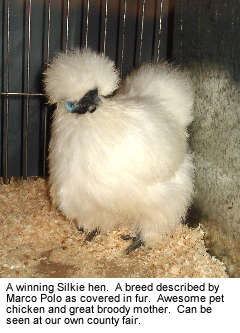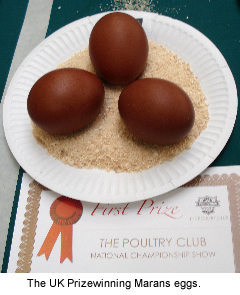home | internet service | web design | business directory | bulletin board | advertise | events calendar | contact | weather | cams

Details about the London Chickens Plus Tour By Jane Gilbertsen December 14, 2010 I am home from England and the huge United Kingdom Poultry Show. The trip, despite the loss of our tour guide and the supposed prepaid tour, was terrific. It gave my roommate, Corbett Gordon, and me a chance to practice our equanimity in the face of a possible wreck. We saw thousands of gorgeous chickens and enjoyed typical but excellent tourist sights. Mixing it up between visiting piles of rock (slang for castles, cathedrals and ruins), excellent museum exhibits, and 5,000 well-groomed chickens was about perfect. The first and last thing I would like to pass on to you is my deep respect for the people that dedicate much of their lives to breeding and caring for a particular species or breed. The British Isles is chock full of obsessive and loving gardeners and animal breeders. The chickens at the show were radiantly healthy and calm in the midst of it all. It took me awhile to appreciate the significance of what I was seeing. I initially thought it was torturous to put a bird through the experience of being alone in a small cage, crammed into a huge room of crowing and quacking birds and enduring close face to face encounters with gawking strangers (science has confirmed chickens recognize individual human faces). I wondered if I was contributing to the inhumane condition of chickens by participatiing as a visitor to the show. I also thought it was questionable whether it was ethical to breed for "perfection" (a show bird winner must match a written "Standard of Perfection"). The standard is defined for conformation which seemed to mean appearance was all that mattered. Some balance was provided by the egg competition and the utility class, where production quality if not quantity, did matter. It helped me to examine some of the recent history of breeding so I will share a bit of that with you. Each breed has a story to tell. Many chickens of ancient breeds, just like so many other living things, were imported into the West during the reign of Queen Victoria, 1837-1901. Enthusiasts had a lot of genetic material to preserve and to manipulate by choosing parent stock of health, production, conformation and beauty to make new breeds. Americans were doing it here, as well, but maybe a bit later as stock moved back across the Atlantic.
Garden innovations during the Victorian Era included the lawnmower, first pulled by a pony at Queen Victoria's home, the glasshouse, commercial pesticides, and imported organic fertilizer. Innovations in transportation, energy and of course, world domination, was helpful here. The increasing size and wealth of the middle classes allowed the luxuries and introductions first controlled by royalty and the upper classes to filter down and fueled further innovation at home. Regular people could get busy and do stuff in their own patch. They HAD a patch. But now, when our modern commercial breeders select for profitable food production, not conformation values, they end up with unintended ugly consequences. For example, aggression, lack of mothering skills, disproportionate body features (big chicken breasts and too weak legs) have been reported. We are breeding chickens to feed billions of people now, not our own families and communities. Profit is short-term not long-term. Appearance, personality and beauty are lost in the mess. Health is controlled by medications not by providing for the chicken's well-being. They eat what is cheap not what is best for them. We have animal factories not dedicated animal husbandry. So what did I learn on this trip? We all owe a big debt to the crazy folks around the world that obsess with their plants and animals. They are keeping alive the genetic stock we will need in the future as the world changes around us. We domesticated these birds and we are now responsible for them. And say a little prayer for the young people - may they continue this quest for "perfection". A word I now know means far far more than appearance - it is enclusive of a healthy relationship between living creatures. It is what "dominion over the fish of the sea, and over the fowl of the air, and over every living thing that movelth upon the earth" is all about. Genesis 1:28 It is about responsibility. Thanks for reading, Jane |

 I can't begin to tell you what all appeared in England besides chickens during that era, but just consider a few things - tender flowering plants, commercial use plants from around the world and exotic tropical fruits. Think of the stories each of these imports could tell! As to chickens, a great number of new breeds came from Asia such as the Brahma, Cochin, Silkie and the Langshan. Queen Victoria loved chickens and today, Prince Charles is a big but controversial chicken keeper and breed club patron. The Great Exhibition of 1851, although largely a technology show, helped fuel the chicken craze of the late 19th Century by the introduction of the new and setting the pace of innovation. Everybody wanted Victoria's favorite chickens!
I can't begin to tell you what all appeared in England besides chickens during that era, but just consider a few things - tender flowering plants, commercial use plants from around the world and exotic tropical fruits. Think of the stories each of these imports could tell! As to chickens, a great number of new breeds came from Asia such as the Brahma, Cochin, Silkie and the Langshan. Queen Victoria loved chickens and today, Prince Charles is a big but controversial chicken keeper and breed club patron. The Great Exhibition of 1851, although largely a technology show, helped fuel the chicken craze of the late 19th Century by the introduction of the new and setting the pace of innovation. Everybody wanted Victoria's favorite chickens!